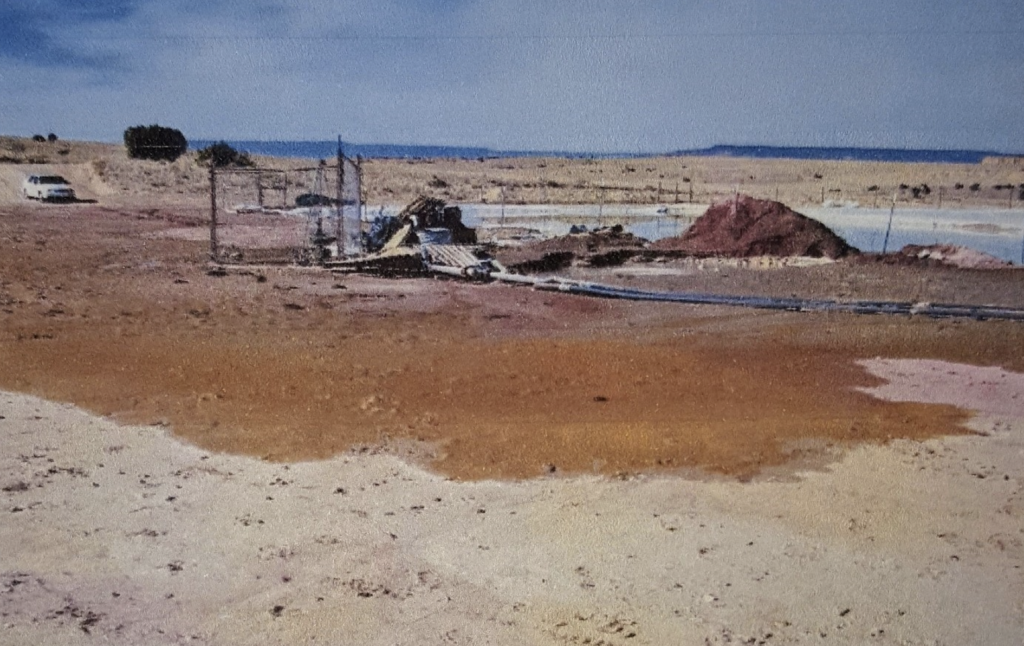Eddie Paulsgrove presents facts surrounding a two-year investigation on the Rio West Brine wells. This material included high amounts of radioactive waste and arsenic among other chemicals. Over 288 tons of toxic salts and soil were dumped into the Rio Rancho landfill. Mr. Paulsgrove graciously offered to make this presentation and we thank him so very much for being here. Naturally Occurring Radioactive Mineral (NORM) Technically Enhanced NORM (TENORM) this is highly concentrated from NORM as the contaminants are compounded into TENORM through evaporation making more toxic. This is also transmitted by air and water very easily. We are discussing the next steps for residents to protect the air and water in the region.
Approximately 288 tons (43 truck loads) of radioactive material has been dumped into the Rio Rancho Waste Management Landfill (located at Northern Blvd and 33rd St in Rio Rancho). This material has been identified to include Radium (226 and 228), which is a silvery-white metal that sends out radiation in the form of rays, waves, or particles. It is part of a mixture of salt and soil that also included high levels of arsenic, sulfate, and chlorides.

The material was derived from contaminated salt water that contained total Radium levels reported to be seventeen times higher than both federal and state maximum allowable limits. This naturally occurring radioactive material is dangerous to everybody – men, women, and children. Exposure to high levels of Radium can cause cancer of the bones, liver, lungs, and breasts. Radium, and its byproduct, Radon gas, can get in the air and be inhaled. It can get into the soil and contaminate drinking water aquifers. [There are several wells that produce drinking water near the landfill.] Importantly, there are numerous schools, businesses, and homes within a one-mile radius of the landfill. And it can be especially dangerous for workers and people who dump their trash at the landfill. The Radium comes from saltwater that was produced from two deep wells drilled west of Rio Rancho for the old Rio West housing development. These wells were drilled in 2007 directed by Sandoval County as part of a desalinization project to produce clean drinking water for the proposed development. They produced large amounts of saltwater pushed to the surface by high pressure. This highly contaminated water was then stored in large pits (also called evaporation ponds) dug into the ground near the wells. Evaporation of the water left behind solid material, which included the dangerous chemicals mixed in with salt. This material was then dumped into the landfill at the direction of the operator/administrator of the wellsite (a private company which had taken over operations from Sandoval County). The operator planned to produce more contaminated saltwater from the two wells, but needed space to store it. So it decided to clean out the pits and dispose of the contaminated material. The operator applied for a permit from the State that would have allowed them to discharge the briny water (and associated contaminated material) legally (the permit was ultimately denied). In anticipation of receiving approval, the operator trucked all the material to the landfill over a two-week period in March 2018. It was inexpensive, easy, and quick to do. But the operator did not inform the Waste Management Landfill people that the 288 tons contained radioactive material. The disposal appears to violate the landfill’s State-issued permit and may also violate State law. Regardless, the action has resulted in significant potential danger. Soon, the landfill will likely be pumping the fluid collected from the liners at the bottom of the facility (“leachate”) and spraying the leachate back on the ground surface and the open environment. As of now, NMED hasn’t required the landfill to test the fluid for radionuclides prior to spraying. NMED has also not stated whether the disposal was a violation. You can contact Rio Rancho Mayor Gregg Hull, the NMED Secretary James Kenney, and other elected officials and request radionuclide leachate testing be conducted prior to spraying.Eddie Paulsgrove, Geologist/Sr. Regulatory Project Manager, US Army Corps of Engineers (ret)Donald T. Phillips, Geologist and Author
Eddie Paulsgrove, Geologist/Sr. Regulatory Project Manager, US Army Corps of Engineers
Donald T. Phillips, Geologist and Author
###Common Ground Community Trust Elaine Cimino. We ask that you to please Contact: NMED Cabinet Secretary James Kenney at the Harold L. Runnels Building // 1190 St. Francis Drive, Suite N4050 // Santa Fe, New Mexico 87505 // tel (800) 219-6157, (505) 827-2855 To Reach Mr> Kenney Email Roose, Rebecca, NMENV
Mayor Greggory D. Hull Mayor ghull@rrnm.gov 3200 Civic Center Circle NE Rio Rancho, NM 87144 505-891-5001 (office) 505-264-5652 (mobile) Fx: 505-891-7274
Acting City Manager Peter Wells 3200 Civic Center Circle NE Rio Rancho, NM 87144 Ph: 505-891-5002 pwells@rrnm.gov
Please ask for a pause on leachate spraying until they test leachate for radioactive NORM and other radioactive contaminants. There are homes, schools and Lowes on Northern Blvd, Loma Colorado and Tulip — We do not have much time. They do this every two years in September We must Protect Our Water and Our Children and Community

No comments:
Post a Comment